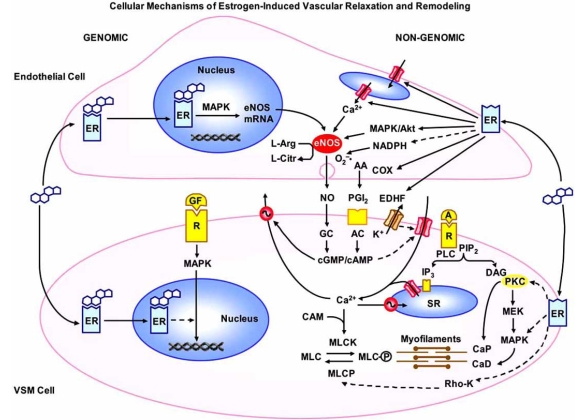Fig. (1).
Cellular mechanisms of estrogen-Induced vascular relaxation and remodeling. In endothelial cells, estrogen binds to cytosolic/ nuclear ERs, activates MAPK, and stimulates gene transcription and eNOS expression. Estrogen also binds to surface membrane ERs and stimulates Ca2+ release from the endoplasmic reticulum, the MAPK/Akt pathway, eNOS activity and NO production. NO activates guanylate cyclase (GC) and increases cGMP which causes VSM relaxation by inhibiting Ca2+ influx and stimulating Ca2+ extrusion. Estrogen’s antioxidant effects cause decreases in NADPH and O2–• production and increases in NO bioactivity. Estrogen also activates cyclooxygenases (COX) and enhances the production of PGI2, which in turn activates adenylate cyclase (AC), increases cAMP, and causes VSM relaxation by mechanisms similar to those of cGMP. ER also increases the release of EDHF, activates K+ channels and causes VSM hyperpolarization and inhibition of Ca2+ influx via Ca2+ channels. Estrogen also activates cytosolic/nuclear ERs in VSM and inhibits growth factor (GF)-mediated activation of MAPK, gene transcription and VSM growth. Estrogen also binds to plasma membrane ERs, decrease [Ca2+]i and inhibit Ca2+- dependent MLC phosphorylation and VSM contraction. Estrogen also inhibits PKC-, MAPK- and Rho kinase and thereby leads to decreases in the myofilament force sensitivity to [Ca2+]i. Dashed arrows indicate inhibition. A: agonist, R: receptor, PLC: phospholipase C, PIP2: phospatidyinositol 4,5-bisphosphate, IP3: inositol 1,4,5-trisphosphate, DAG: diacylglycerol, SR: sarcoplasmic reticulum, CAM: calmodulin, MLC: myosin light chain, MLCK: MLC kinase, MLCP: MLC phosphatase, MEK: MAPK kinase, CaP: calponin, CaD: caldesmon.

